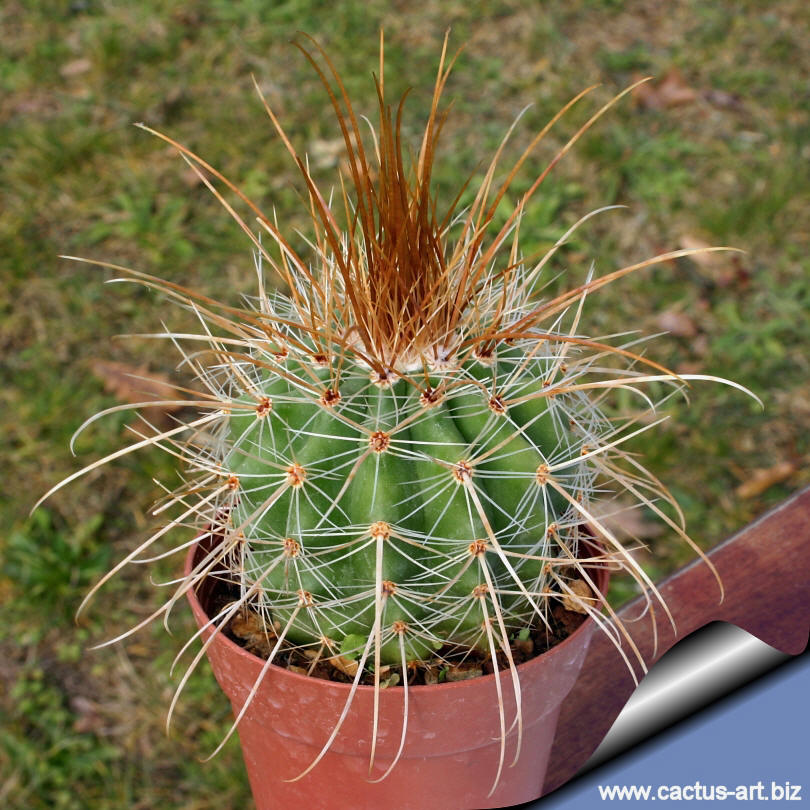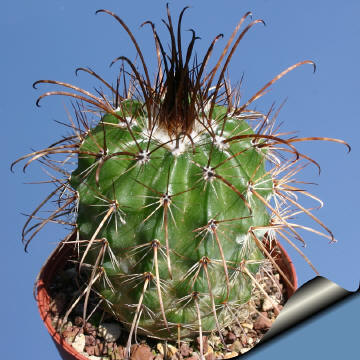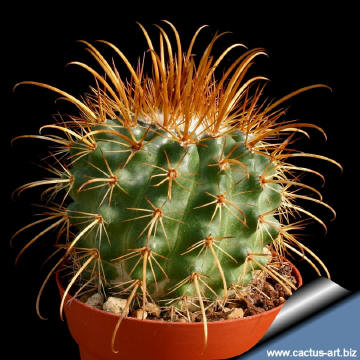|
|
|

Parodia masii
|
 |
 |
|
It
is a very variable species, with dense,
strong and curved spination,
often yellow or amber-coloured. |
|
Propagation: By
Seeds. The seeds of this plant are extremely
small, and must be sown on the surface of the germination substrate (not
buried!!) But the seedlings after germination are so minuscule and
delicate that it is quite problematic to keep them alive. So for this
species one usually uses the
baggy germination technique (in a sterilized pot hermetically closed
in a plastic bag.
Photo of
conspecific taxa, varieties, forms and cultivars of
plants belonging to the Parodia
maassii
complex
(This
Taxon has lots of
synonyms (like most Parodia), with several controversial varieties and
subspecies):
|
|
Advertising
|
|
|
|
|
|
|
Family:
Cactaceae (Cactus
Family)
Scientific name: Parodia maassii (masii or massii) ((Heese)
A. Berger
Kakteen (Berger) 344, 1929
Origin: It is native to
Southern Bolivia and
Northern Argentina.
Conservation status: Listed in
CITES appendix 2.
Synonyms:
- Echinocactus maasii
Heese
- Malacocarpus maassii
- Bolivicactus maassii
|
|
Description: Solitary or clumping. This species is very variable.
Stem: The plant presents an extended spherical stem, mid-green to
intense green in color, 15 cm. wide, with the apical part densely
covered with white wool.
Ribs: 13- 21, chinned and arranged in spiral.
Areoles: Big and woolly at first, but they become naked with
age.
Spines: Curved, dense, and variably coloured.
Radial spines: 8-10 (or more). Usually yellowish or amber at first
and white later, 5-10 mm. long, opened on the outside and a little
curved inwardly.
Central spines: 1-4 (or more), strong, measuring between 3
and 7 cm. They are yellow on the upper part of the plant and go
upwards. In older parts they become clear yellow, and go
downwards.
Flowers: Funnel-shaped, large coppery-yellow or orange, but they
can also be carmine or red with an orange centre. 3 (or more) cm across.
Blooming season: Spring and summer, they usually appear one by
one in succession.
|
|
|
|
Cultivation: Water these plants moderately but regularly, and fertilize with a low nitrogen
fertilizer every 6 to 8 weeks, from mid-spring to late summer. This plant
should remain dry at other times, except for a quick, periodic misting on
warmer days in late winter. Watering Needs: Regular water in
summer. Keep rather dry in winter. It rots easily if the substrate is wet
and cold, and tends to lose its roots in winter. It can tolerate light frost (-1C°). This species grows better with partial
shade.
If your climate is warm enough to grow this plant outside, be sure that
soil is well drained and sun if full, but with protection from strong
mid-day rays.
Other
Synonyms:
- Parodia maassii v. albescens
F. Ritter,
Succulenta (Netherlands): 179. 1963, 1963
- Parodia maassii v. auricolor
- Parodia maassii v.
carminatiflora F. Ritter,
Succulenta (Netherlands): 179. 1963, 1963
- Parodia maassii v. commutans
(F. Ritter) Donald & Rowley
- Parodia maassii v. commutans
maxima (F. Ritter) Don. & Rowley
- Parodia maassii v. intermedia
F. Ritter,
Succulenta (Netherlands): 179. 1963, 1963
- Parodia maassii v. multispina
Parodia maassii v. nigrispina Y. Ito,
The Cactaceae: 453, without type, 1981
- Parodia maassii v. rectispina
- Parodia maassii v. rubrispina
Y. Ito,
The Cactaceae: 453, without type, 1981
- Parodia maassii v. shaferi
F. Ritter,
Succulenta (Netherlands): 179. 1963, 1963
- Parodia maassii v.
subterranea (F. Ritter) Krainz
- Parodia thieleana
- Parodia mendeziana
- Parodia lamprospina
- Parodia koehresiana
- Parodia
knizei
- Parodia haageana
- Parodia escayachensis
(Vaupel) Backeb
= Echinocactus escayachensis Vaupel
- Parodia otaviana
Cárdenas
- Parodia suprema
F.Ritter
- Parodia haageana
- Parodia castanea
- Parodia camargensis
- Parodia bermejoensis
Brandt
- Parodia belliata
- Parodia obtusa var. atochana
- Parodia obtusa ssp. atochana,

 |
|